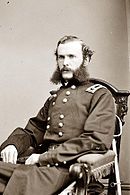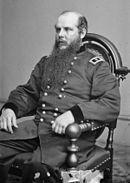
Thomas Carmichael Hindman Jr. was an American lawyer, politician, and a senior officer of the Confederate States Army during the American Civil War. Born in Knoxville, Tennessee, he later moved to Mississippi and became involved in politics. Having served in the Mexican–American War from 1846 to 1848, Hindman practiced law and in 1853 was elected to the Mississippi House of Representatives. After his term expired in 1854, he moved to Helena, Arkansas where there were more opportunities for his political ambitions.

The Battle of Prairie Grove was a battle of the American Civil War fought on December 7, 1862. While tactically indecisive, the battle secured the Union control of northwestern Arkansas.
The Battle of Cotton Plant also known as Action at Hill's Plantation or Action at Cache River or Action at Round Hill was fought during the American Civil War in Woodruff County, Arkansas. Frustrated in its attempt to march to Little Rock by a lack of supplies, the Union Army of the Southwest under the command of Samuel Ryan Curtis moved south down the White River. Curtis's army encountered a Confederate force led by Albert Rust on the east bank of the Cache River near Cotton Plant. Rust was only able to bring two Texas cavalry regiments into action. These horsemen attacked the Federal advance guard under Charles Edward Hovey, but after a spirited fight, Union reinforcements arrived and drove off the Texans. Rust's force made a disorderly retreat and Curtis's army was able to march south to Clarendon before veering east to occupy Helena on the Mississippi River.

John McAllister Schofield was an American soldier who held major commands during the American Civil War. He was appointed U.S. Secretary of War (1868–1869) under President Andrew Johnson and later served as Commanding General of the United States Army (1888–1895).

The Battle of Cane Hill was fought between Federal and Confederate forces during the American Civil War on November 28, 1862, in northwestern Arkansas, near the town of Cane Hill. Federal troops under Brigadier General James G. Blunt had entered northwestern Arkansas, and Major General Thomas Hindman of the Confederate Army sent a force under Brigadier General John S. Marmaduke to Cane Hill, which was also known as Boonsboro, to collect supplies. Hindman had begun a campaign in which he hoped to catch Blunt's command while it was isolated from the rest of the Federal Army of the Frontier, which was near Springfield, Missouri. In early November, a detachment of Blunt's command led by Colonel William F. Cloud defeated a small Confederate force commanded by Colonel Emmett MacDonald in the Cane Hill area.
The Army of the Frontier was a Union army that served in the Trans-Mississippi Theater during the Civil War. It fought in several minor engagements in Arkansas, Indian Territory, and Kansas. In June 1863 the Army was discontinued but many of its regiments were formed into the District of the Frontier.

The First Battle of Newtonia was fought on September 30, 1862, between Confederate soldiers commanded by Colonel Douglas H. Cooper and a Union column commanded by Brigadier General Frederick Salomon near Newtonia, Missouri, during the American Civil War. Cooper's force had moved into southwestern Missouri, and encamped near the town of Newtonia. The Confederate column was composed mostly of cavalry led by Colonel Joseph O. Shelby and a brigade of Native Americans. A Union force commanded by Brigadier General James G. Blunt moved to intercept Cooper's force. Blunt's advance force, led by Salomon, reached the vicinity of Newtonia on September 29, and attacked Cooper's position on September 30. A Union probing force commanded by Colonel Edward Lynde was driven out of Newtonia by Cooper's forces on the morning of the 30th.
The Battle of Old Fort Wayne, also known as Maysville, Beattie's Prairie, or Beaty's Prairie, was an American Civil War battle on October 22, 1862, in Delaware County in what is now eastern Oklahoma.

During the American Civil War, Arkansas was a Confederate state, though it had initially voted to remain in the Union. Following the capture of Fort Sumter in April 1861, Abraham Lincoln called for troops from every Union state to put down the rebellion, and Arkansas and several other states seceded. For the rest of the civil war, Arkansas played a major role in controlling the Mississippi River, a major waterway.

James S. Rains was a senior officer of the Missouri State Guard (MSG) who fought in the Trans-Mississippi Theater of the American Civil War. Born in Tennessee, Rains moved to Missouri by 1840, and was a farmer, politician, judge, and militia officer. He also served as an Indian agent from 1845 to 1849, and participated in the California Gold Rush. He was appointed to command of the 8th Division of the MSG in May 1861, and may have commanded all MSG forces at the Battle of Carthage later that year. In August, his men were routed at the Battle of Dug Springs, an incident which became known as "Rains's Scare".
The following Union Army units and commanders fought in the Battle of Prairie Grove of the American Civil War on December 7, 1862, in Washington County, Arkansas. The Confederate order of battle is listed separately.

The 22nd Arkansas Infantry Regiment was a Confederate Army infantry regiment during the American Civil War (1862–1865). This regiment was originally organized as the 17th Arkansas Infantry Regiment, reorganized after the battle of Pea Ridge as 1st Regiment, Northwest Division, Trans-Mississippi Department, or Rector's War Regiment, redesignated as the 35th Arkansas in the summer of 1862, and reorganized and redesignated as the 22nd Arkansas following the Battle of Prairie Grove. The unit was also sometimes referred to as, King's Arkansas Infantry or McCord's Arkansas Infantry. This was the second regiment to be officially designated as the 22nd Arkansas. The first was mustered in at DeValls Bluff, Arkansas, on April 9, 1862, and later reorganized as the 20th Arkansas Infantry Regiment.
The Battle of Van Buren was fought in Crawford County, Arkansas, on December 28, 1862, during the American Civil War. After defeating Confederate forces led by Major General Thomas C. Hindman at the Battle of Prairie Grove on December 7, 1862, Union forces under Brigadier Generals James G. Blunt and Francis J. Herron prepared for a raid against the Confederate positions at Van Buren and Fort Smith. Disease, lack of supplies, and desertion had previously forced Hindman to begin withdrawing most of his force from the area. Setting out on December 27, the Union troops struck an outlying Confederate cavalry unit near Drippings Spring, north of Van Buren, on the morning of December 28. The Confederate cavalry fled to Van Buren, which was then overrun by Union troops.
Reid's Arkansas Battery (1862), was a Confederate artillery battery that served during the American Civil War. Another Arkansas battery, the 1st Arkansas Light Artillery, a.k.a. the Fort Smith Artillery, was also once known as "Reid's Battery". Captain Reid had commanded the Fort Smith Artillery during the Battle of Wilson's Creek, but left that organization and later organized a second battery that is the subject of this article.

7th Missouri Cavalry Regiment was a cavalry unit from Missouri that served in the Union Army during the American Civil War. The regiment was formed on 20 February 1862 by merging Bishop's Cavalry Battalion with some unattached cavalry companies. The regiment fought at Independence, Lone Jack, Prairie Grove and Van Buren in 1862. The unit participated in Frederick Steele's expedition to Little Rock in 1863, fighting at Brownsville, Ashley's Mills, and Bayou Fourche. In 1864, the regiment went on the Camden Expedition and fought at Mount Elba and Marks' Mills. The remaining soldiers were consolidated with the 1st Missouri Volunteer Cavalry Regiment on 22 February 1865.

Battery E, 1st Missouri Light Artillery Regiment was an artillery battery unit from Missouri that served in the Union Army during the American Civil War. The 1st Missouri Light Artillery Regiment formed on 1 September 1861. The battery participated in Frémont's expedition to Springfield in October 1861. This was followed by actions at Prairie Grove and Van Buren in December 1862. The following year, the battery fought at Cape Girardeau, Chalk Bluff, Vicksburg, the Expedition to Morganza, Brownsville, and Fort Esperanza. After performing garrison duty at Brownsville, Texas, the unit was mustered out in June 1864. For a few months at the end of 1864, a Pennsylvania battery took the name of this unit.
The 16th Missouri Infantry Regiment (also known as Jackman's Missouri Regiment, Caldwell's Missouri Regiment, and the 7th Missouri Infantry Regiment (Lewis')) was an infantry regiment that served in the Confederate States Army during the American Civil War. The regiment was formed from men recruited by Jeremiah V. Cockrell and Sidney D. Jackman during an expedition into Missouri in August 1862. Although the recruits fought at the Battle of Lone Jack on August 16, they were not officially mustered into Confederate service until August 31. The regiment fought at the Battle of Prairie Grove on December 7. In May 1863, the regiment was designated the 7th Missouri Infantry Regiment, although this designation was changed to the 16th Missouri Infantry Regiment in December. On July 4, the regiment fought at the Battle of Helena, suffering heavy casualties. The unit then spent time building fortifications at Little Rock, Arkansas, before leaving the town in September. The 16th Missouri then fought at the Battle of Pleasant Hill on April 9, 1864, and at the Battle of Jenkins' Ferry on April 30. On June 8, 1865, the men of the regiment were paroled and sent back to Missouri via steamboat. More men died while serving in the 16th Missouri Infantry Regiment than died in any other Missouri unit serving in the Confederate States Army.

The 1st Missouri Field Battery was a field artillery battery that served in the Confederate States Army during the American Civil War. The battery was formed by Captain Westley F. Roberts in Arkansas in September 1862 as Roberts' Missouri Battery and was originally armed with two 12-pounder James rifles and two 6-pounder smoothbore guns. The unit fought in the Battle of Prairie Grove on December 7, as part of a Confederate offensive. Roberts' Battery withdrew after the battle and transferred to Little Rock, Arkansas, where Roberts resigned and was replaced by Lieutenant Samuel T. Ruffner.

The 8th Missouri Infantry Regiment was an infantry regiment of the Confederate States Army during the American Civil War. From May 1861, the war began affecting events in the state of Missouri. In 1862, Confederate recruiting activities took place in Missouri, and a cavalry regiment was formed in Oregon County, the nucleus being former members of the Missouri State Guard. On September 2, the unit entered Confederate service, but it was reclassified as infantry ten days later. After many of the men transferred to other units, the regiment was reclassified as a battalion on October 19 and named the 7th Missouri Infantry Battalion, also known as Mitchell's Missouri Infantry. It participated in a Confederate offensive at the Battle of Prairie Grove on December 7. During the battle, the unit made several charges against the Union lines but was repeatedly repulsed by artillery fire. The regiment spent most of early 1863 encamped near Little Rock and Pine Bluff in Arkansas.

The 9th Missouri Sharpshooter Battalion, also known as Pindall's Missouri Sharpshooter Battalion, was a unit that served in the Confederate States Army during the American Civil War. The battalion was formed in late 1862, in compliance with an earlier authorization by the Confederate States Congress for each brigade to have an associated battalion of sharpshooters. When first formed, the men had no unique qualifications to serve as sharpshooters and were drawn from a defunct artillery battery, a partisan rangers unit, and infantrymen. The unit's first major battle was the Battle of Prairie Grove in December 1862.
















